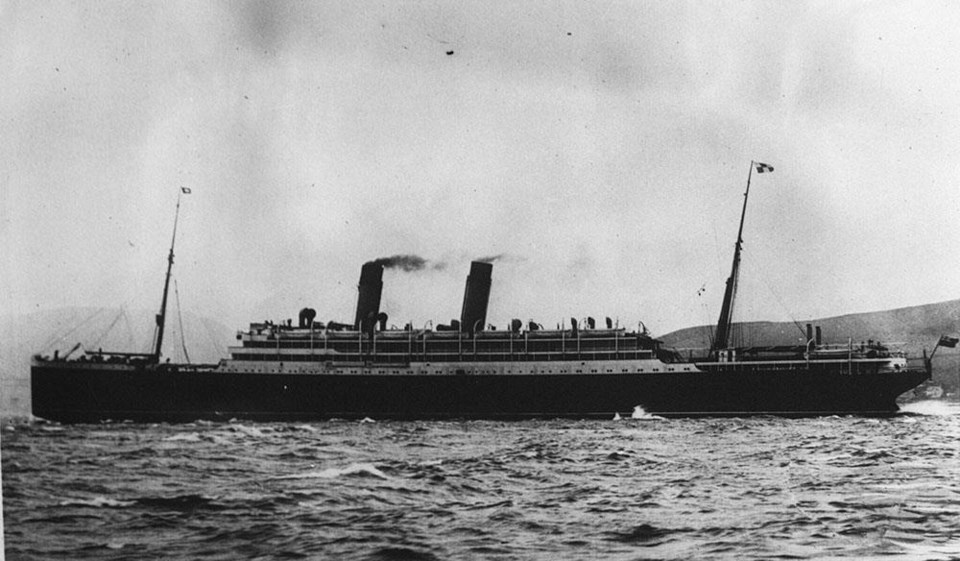In August 2019, I was sitting in a Zodiac in the middle of the St. Lawrence River piloted by a French Canadian marine biologist.
The trip was arranged by Hugh Verrier, and we were right above the wreck of the Empress of Ireland, a CPR-liner that sunk in 14 minutes after being rammed by a Norwegian coal ship on May 29, 1914.
It’s now an underwater graveyard for more than 1,000 souls.
Verrier is based in New York and heads up one of the world’s largest law firms, but he is originally from Montreal, and has a summer property near Rimouski, close to where the Empress of Ireland sank. In recent years he has developed a fascination for the story of survivor Gordon Davidson who taught history in Vancouver.
Verrier hired me two years earlier to research Davidson’s story.
Davidson had reportedly survived the sinking of the Empress by swimming 6.5 kilometres to shore. When Verrier looked into this, experts told him this wasn’t possible – not at that time of year and not for that distance. But Verrier wanted to make sure. He wanted to verify the information that had been repeated in newspaper articles and regurgitated in books and even at Davidson’s own memorial service more than a hundred years ago.
While any Canadian school kid can tell you the story of the Titanic, I bet very few know about the Empress of Ireland.
I was surprised that I’d never heard of the ship or the tragedy, because the loss of Canadian life was truly staggering. More civilian passengers died that night (836 passengers, plus 176 crew members), than died on the Titanic (832 passengers, plus close to 700 crew members) in 1912, or on the Lusitania (788 passengers, plus more than 400 crew members) two years later. It stands as the worst maritime disaster during peacetime in Canadian history.
Davidson did not, in fact, swim to shore – that story came from the wild speculations of a Province newspaper reporter and later went around the world as fact.
While researching Davidson’s story, I was surprised by how many connections there were to Western Canada – 65 people booked through the Vancouver office alone.
Of the 1,056 passengers on board, only 220 survived. Two people who died that night were from North Vancouver.
According to the North Shore Press on May 29, 1914 – the same day the Empress sank – Ethel Berry, 20, of 242 10th Street was travelling to Surrey, England to spend a few months with her grandmother. She had in her charge six-year-old Dorothy Balcombe of 245 East 15th Street, who was going to stay with her grandfather in Belgium. Both young ladies were in second class. Hours after he learned of the sinking, Ethel’s father received a telegram from his daughter in Quebec saying “all’s well.” Later he would find out that she was among the lost.
When researching John Langley, a survivor from B.C., I found two of his grandchildren living in North Vancouver. Geoff Langley is a Deep Cove resident of 64 years, while his cousin Karen Davidson has lived in North Vancouver since 1966.
John Langley immigrated from Ireland a few years before the sinking and bought Willow Grange, a cattle ranch in Canford. He was travelling back to Ireland to look after some property matters. Just hours after his wife Bessie received a letter from the CPR asking her to come to Quebec City to identify his body, she received a letter from her husband detailing his harrowing survival. Langley managed to get up on deck by squeezing his six-foot frame through a porthole measuring just 30.5 centimetres in diameter. He was sucked down into the vortex as the ship sank and survived by clinging to an overturned lifeboat. The family kept his letter and the purple pyjamas he was wearing.
The Empress of Ireland carried more than 117,000 people between England and Canada from 1906 to 1914. Supposedly, a million or so Canadians can trace their roots back to an ancestor who came to Canada on this ship. If that’s true, that’s roughly one in 40 of us. That’s reason enough to have this ship become part of our collective consciousness.
Eve Lazarus is a North Vancouver resident and author. Her latest book is Beneath Dark Waters: The Legacy of the Empress of Ireland Shipwreck. [email protected]



